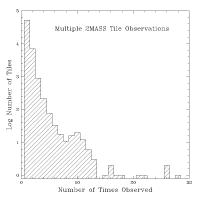
The 2MASS All-Sky Data Release contains data drawn from 59,731 scans of Tiles covering 99.998% of the sky. 59,650 of these scans cover normal Survey Tiles, and 81 cover special "gap-fill" Tiles (cf. III.2.b) designed to fill sky coverage gaps produced by small telescope pointing offsets. The time spanned by these observations includes the entire range of Survey operations, from 1997 June 7 to 2000 December 1 UT at Mt. Hopkins, and 1998 March 18 to 2001 February 15 UT at CTIO.
The 59,731 scans in the All-Sky Release were selected from among the 70,712 scans that were included in final 2MASS data processing. Only scans known to have been taken under nominally photometric conditions underwent final processing, and all were assigned a quality score based on the application of uniform criteria during quality assessment. Thus, scan selection for the All-Sky Data Release is based on uniformly applied quality criteria.
51,709 of the Tiles included in final processing were observed only once during the Survey in conditions known to satisfy quality requirements. These are included in the All-Sky Release, by default.
Approximately 14% (8,266) of the Survey Tiles were observed multiple times during Survey operations and have more than one scan available with data that meets the Survey quality standards. The frequency distribution of the 2MASS Tile observations included in the final round of data processing is shown in Figure 1. Most of the multiply-observed Tiles were scanned twice, but a few were observed >10 times.
One scan of each multiply-observed Tile was selected for inclusion in the All-Sky Release using the following data-quality based-criteria:
where ZP is the photometric zero point offset applied to the scan (IV.8), and PSP is the photometric sensitivity parameter that estimates the magnitude at which SNR=10 based on atmospheric backgrounds and seeing quality (VI.2).
For scan i, dS is the sum of dSb over the three bands: dS = dSJ + dSH + dSKs
Select the scan with max(dS)
As an example of this filtering process, consider Tile 3117 (ra,dec=15.65o,+8.93o) which was observed six times during the Survey. Five of these six scans were assigned the highest quality score of 10 during QA review (cf. IV.10). Table 1 lists the observation date, observatory hemisphere and net relative sensitivity (dS) derived for the five high quality scans. Note that this scan was observed from both observatories on the night of 2000 October 17 UT. The observation made from Mt. Hopkins on 2000 October 15 UT has the maximum value of dS and was selected for inclusion in the All-Sky Release.
| Date (UT) | Hemis | dSi (mag) | 001007 | n | +0.0000 | 001015 | n | +0.7408 | 001016 | n | +0.5696 | 001017 | s | +0.7204 | 001017 | n | +0.4336 |
|---|
The final adjustment to the scan selection procedure considers cases for multiply-observed Tiles where selection of a scan different than the one with the best net relative sensitivity can improve the sky coverage of the All-Sky Data Release.
As discussed in III.2.c, at the end of Survey operations there were a number of coverage gaps between Tiles due to small telescope pointing errors. There were 41 instances of Tiles having multiple scans with the same best quality where selection of an alternate best-quality scan either filled-in or reduced the remaining coverage gaps. All of these alternates were selected for the All-Sky Release.
During the process of checking sky coverage for the Release, 244 of the special "gap-fill" Tiles were found to duplicate coverage of regular Survey Tiles or other gap-fill Tiles. These were not included in the Release.

|
| Figure 1 |
[Last Update: 24 March 2003, by R. Cutri]